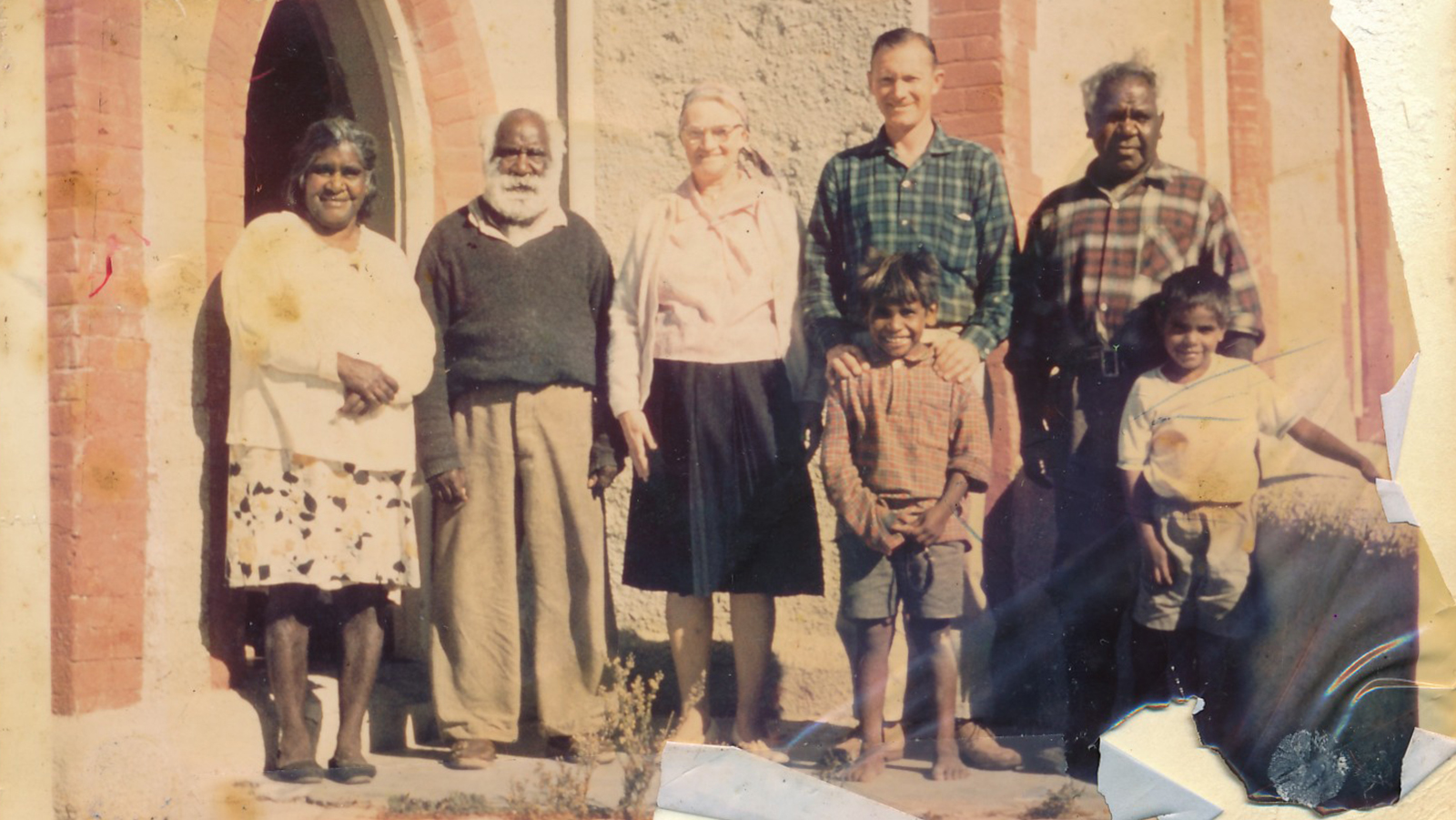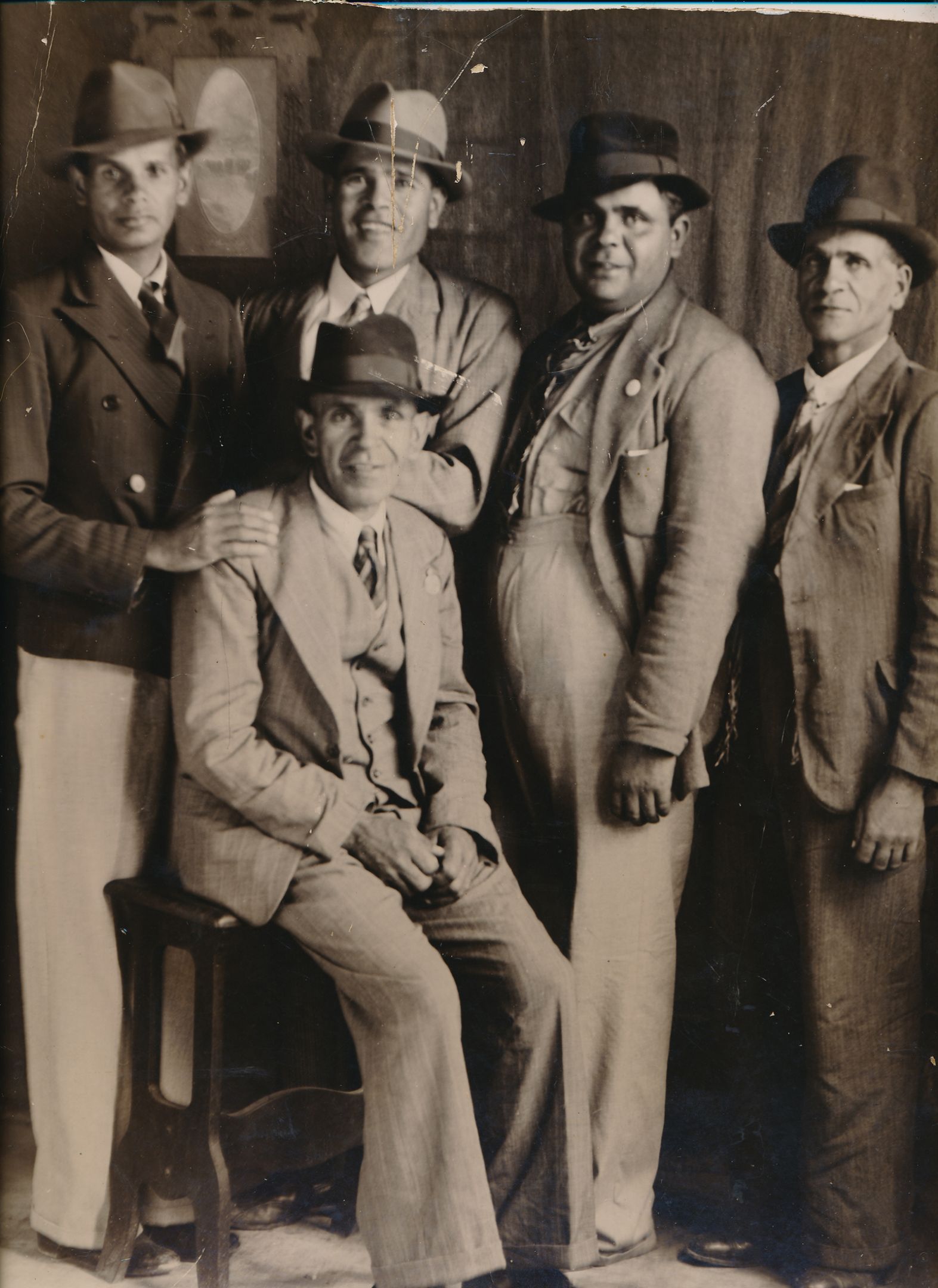Photographic project to reveal the history of the Ngarrindjeri people

Aunty Annie Rankine “Fofon”, Uncle Banks Long, an unidentified non-Indigenous woman and man, Uncle Telford “Hooksy” Unaipon and two children, standing outside the church at Raukkan, formerly the Point McLeay Mission, circa 1960. Annie Rankine was the first woman to chair an Aboriginal Community Council. Telford Unaipon is the nephew of David Unaipon who is featured on the Australian $50 note. Photo: Helen Jackson Collection.
Aboriginal and Torres Strait Islander readers are advised that this article may contain images of people who have died.
In summary
- An electronic archive will offer new insights into the way the people of the Ngarrindjeri Nation in south-eastern Australia lived over the past 150 years
- The project focuses on community photographs taken by nonprofessional photographers and archives in the control of Indigenous custodians
- It is funded by the South Australian government and an Australian Research Council Discovery grant
A project to create a living digital archive of photographs and stories of the Ngarrindjeri people of south-eastern Australia aims to ensure the longevity and accessibility of their heritage.
The Ngarrindjeri Photography Project is led by Swinburne University of Technology researcher Dr Karen Hughes, an expert in Indigenous photographic histories, microhistory and Ngarrindjeri history. She has partnered with Aunty Ellen Trevorrow from the Ngarrindjeri community and with Moorundi Aboriginal Community Controlled Health Service and Ngarrindjeri Ruwe Empowered Communities.
It will be the first such large-scale archive for a distinct Aboriginal nation in south-eastern Australia and is funded by the South Australian government and an Australian Research Council Discovery grant.
Dr Hughes says the project was instigated by Ngarrindjeri elders who were keen to share and preserve their photos and stories.

Gathering of Ngarrindjeri Veterans from the First World War and the Second World War: from left to right, Proctor Sumner (Uncle Nink), Howard Sumner, Steve (Uncle Fuller) Lampard, Wiltshire Sumner, seated, Walter Gollan, possibly taken at Raukkan Hall on Remembrance Day. Courtesy of Aunty Sandra Wilson. Photographer unknown.
Historical photos are ‘powerful narrative tools’
“Elders of the Ngarrindjeri Nation in south-eastern Australia hold a vast but dispersed collection of rare historical photographs in personal archives which they want to collate, document, conserve and exhibit to the Australian public,” Dr Hughes says.
“As personal cameras became available from the 1920s, Indigenous people used them to record their own visual histories. Yet such photographs are rarely circulated and are under-researched.
“Historical photographs taken and owned by Indigenous people have proved to be powerful narrative tools that can restore family connections, redraw community histories and represent relationships.”

Albert (Bronco) Lovegrove (b 1924), pictured playing his guitar near the River Murray, circa 1940s. Famed for his horsemanship and music, Albert travelled around Australia with a circus in the 1940s. Courtesy of Lynnette Lovegrove-Niemz. Photographer June Lovegrove.

Maria Lane (nee Rigney) in front of the old cottages at Raukkan, circa 1965. Maria later became a senior academic in Aboriginal education at the University of South Australia. Courtesy of Lena Rigney. Photographer unknown.
Focusing on community photographs taken by nonprofessional photographers and archives in the control of Indigenous custodians, the project will fill an important gap, advancing understanding of Indigenous self-representation.
To date 2,784 images have been collected. Taken almost solely by Ngarrindjeri photographers, they offer a unique access to the social spaces of Aboriginal lives in the mid twentieth century.
“Collaborating with the Ngarrindjeri people to contextualise this important, time-sensitive archive is urgent, while Elders who possess knowledge about the events, people and environment the photos depict are still with us,” Dr Hughes says.
She will examine new historical perspectives arising from the project’s photo and story recovery process. Anthropologist and Australia’s first Indigenous Rhodes Scholar, Rebecca Richards, has been appointed as a postdoctoral research fellow on the project to conduct research on Ngarrindjeri photographic archives and to enable Ngarrindjeri communities to access these photographs.
The project has also engaged Swinburne Indigenous student Grace Auld to create the digital collection.
If you would like to contribute to this project, contact Dr Karen Hughes at karenhughes@swin.edu.au
Swinburne University of Technology is the first Australian university to have its Reconciliation Action Plan recognised at the highest level of Elevate. Through its RAP Swinburne has significantly expanded and prioritised its Indigenous research and employment culture, including increasing Indigenous postdoctoral fellows, PhD scholarships and internal seed funding opportunities.
-
Media Enquiries
Related articles
-

- Social Affairs
Swinburne is committed to reconciliation “Now More Than Ever”
Swinburne held events across our three campuses to mark National Sorry Day and National Reconciliation Week.
Friday 31 May 2024 -

- Social Affairs
Landmark Swinburne study exposes ongoing discrimination and homophobia
More than half of LGBTIQA+ young people in Australia have witnessed discrimination in community-based sport, according to a new Swinburne University of Technology study.
Friday 17 May 2024 -

- Social Affairs
Too many renters swelter through summer. Efficient cooling should be the law for rental homes
Summer is coming – and it’s starting earlier, becoming hotter and lasting longer. As the hot weather hits, many renters will be sweltering in their homes. The World Health Organization recommends a list of actions for people to deal with heat. At the top of the list is “keep your home cool”. But for many renters, this isn’t possible.
Wednesday 22 November 2023 -

- University
- Social Affairs
In 5 years, this Australian astrophysics lab reached 50% women. Here’s how they did it
Many organisations, from community sporting groups to the United Nations, have set themselves a target of gender parity: ensuring half of staff or members are women. Gender parity is desirable because training and retaining equal halves of a population’s available talent influences an organisation’s growth, problem-solving capacity and future-readiness.
Friday 17 November 2023 -

- Social Affairs
Swinburne students win third consecutive Advertising Capstone Challenge
Four Swinburne students have designed a winning campaign for BONDS Bloody Comfy Period Undies.
Friday 10 November 2023

